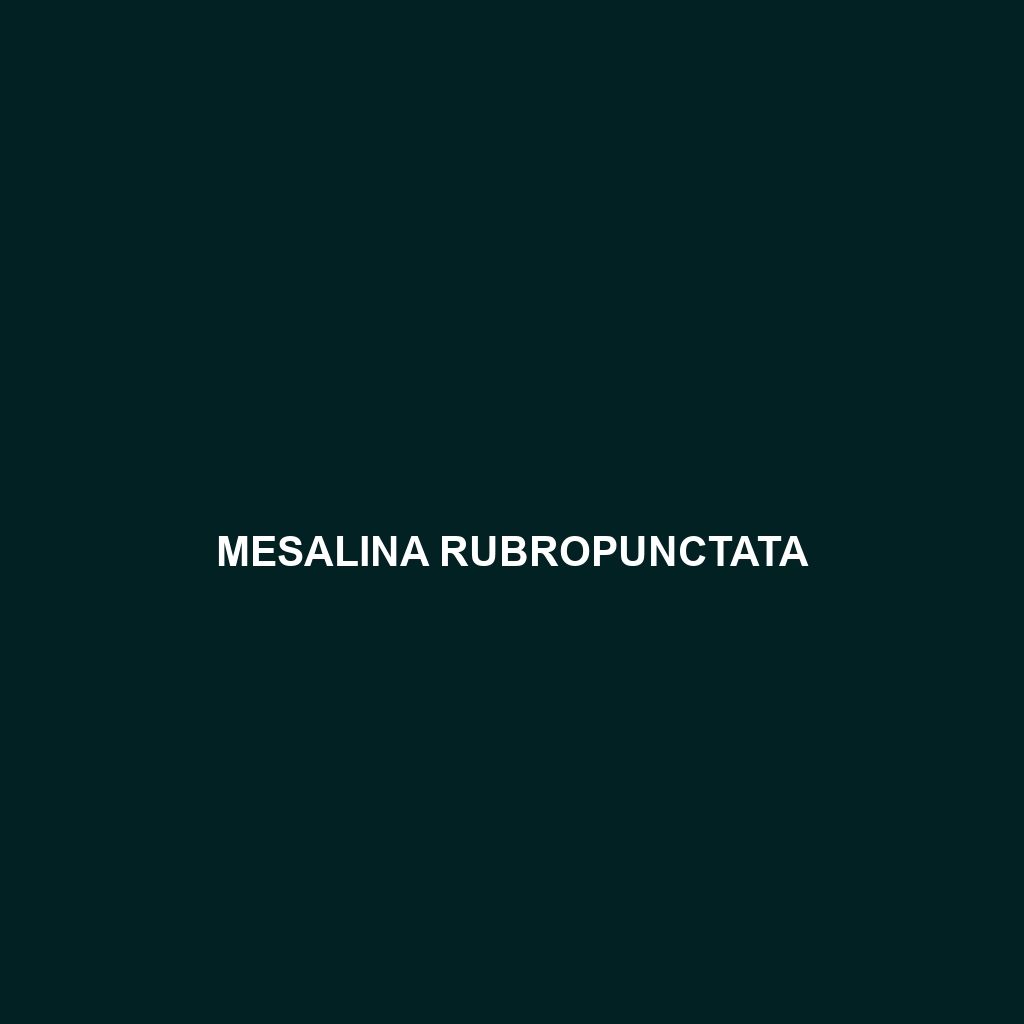Common Name
Mesalina rubropunctata
Scientific Name
Mesalina rubropunctata
Habitat
Mesalina rubropunctata, commonly known as the Red-spotted Sand Lizard, is predominantly found in arid regions of North Africa and parts of the Middle East. This species thrives in a variety of habitats, including sandy deserts, dry savannas, and rocky landscapes. The climate in these areas is typically characterized by extreme temperatures, with scorching days and cooler nights. These lizards are often seen basking in the sun to regulate their body temperature, which is essential for their survival in such demanding environments. They make use of their burrowing abilities to create shelters and regulate their temperature more effectively. Due to their adaptability, they can also be found near human settlements, often inhabiting disturbed areas.
Physical Characteristics
Mesalina rubropunctata is a medium-sized lizard, with adults typically measuring between 20 to 30 centimeters in length. Its elongated body is covered with smooth scales that allow for efficient movement across sandy surfaces. One of its most distinctive features is the vibrant red or orange spots that pepper its back, providing not only aesthetic appeal but also a form of camouflage among the sandy terrains it inhabits. The lizard possesses a slender tail, which can be shed as a defense mechanism against predators, allowing it to escape while the tail distracts the threat. This unique coloration and morphology make Mesalina rubropunctata easily recognizable among other lizard species.
Behavior
The behavior of Mesalina rubropunctata exhibits several fascinating traits. Primarily a diurnal species, these lizards are most active during daylight hours, using their keen eyesight to hunt and avoid predators. They engage in regular basking periods, ensuring they maintain optimal body temperatures for their metabolic functions. Their social structure can vary; while some may observe solitary habits, others are known to exhibit territorial behaviors, especially during the mating season. Interestingly, they perform elaborate courtship displays which include head bobs and tail movements to attract potential mates. This mating ritual is not only a method of communication but also an essential part of their reproductive success.
Diet
Mesalina rubropunctata is primarily an insectivore, feeding on a diverse range of insects, including ants, beetles, and grasshoppers. Their diet may occasionally include other small invertebrates, allowing them to obtain the necessary protein for growth and reproduction. These lizards exhibit ambush feeding tactics, using their agility to quickly snap up prey. Their feeding pattern generally follows a high-energy expenditure during the day, coinciding with peak insect activity. Adaptations in their foraging strategy and diet contribute to their resilience in arid environments, ensuring survival even during periods of limited food availability.
Reproduction
The reproductive cycle of Mesalina rubropunctata is typically seasonal, correlating with warmer months. Mating usually occurs in the spring, when temperatures begin to rise, and females lay eggs shortly after, usually between late spring and early summer. A female can lay between 3 to 10 eggs per clutch, which she buries in sandy soil to protect them from predators and temperature fluctuations. The incubation period lasts around 4 to 8 weeks, depending on environmental conditions. Upon hatching, the juveniles are independent and must fend for themselves from the outset, showcasing their survival skills early in life.
Conservation Status
The current conservation status of Mesalina rubropunctata is classified as ‘Least Concern’ according to the IUCN Red List. However, like many species, it faces challenges from habitat loss due to urbanization, agricultural expansion, and climate change. Conservation efforts are crucial to monitor populations and protect their natural habitats. Furthermore, education and awareness programs can play a significant role in mitigating human impact on their ecosystems, ensuring that this resilient species continues to thrive.
Interesting Facts
One of the most fascinating aspects of Mesalina rubropunctata is its remarkable ability to change color slightly in response to environmental conditions, a trait that aids in thermoregulation and camouflage. These lizards can also perform unique defensive displays, including feigning death or playing dead when threatened by predators. Additionally, they have a very high metabolic rate, which necessitates regular feeding and activity levels. Their adaptability to both natural and modified habitats demonstrates their ecological resilience.
Role in Ecosystem
Mesalina rubropunctata plays a significant role in its ecosystem as both predator and prey. As insectivores, they help control insect populations, contributing to the balance of their environment. Their presence serves as a food source for larger predators, including birds and small mammals, thereby integrating them into the food web. Through their burrowing activities, they also aerate the soil, which benefits plant growth and overall ecosystem health. Overall, the Red-spotted Sand Lizard is an integral component of the biodiversity within its habitat, highlighting the importance of preserving such species for ecological stability.
